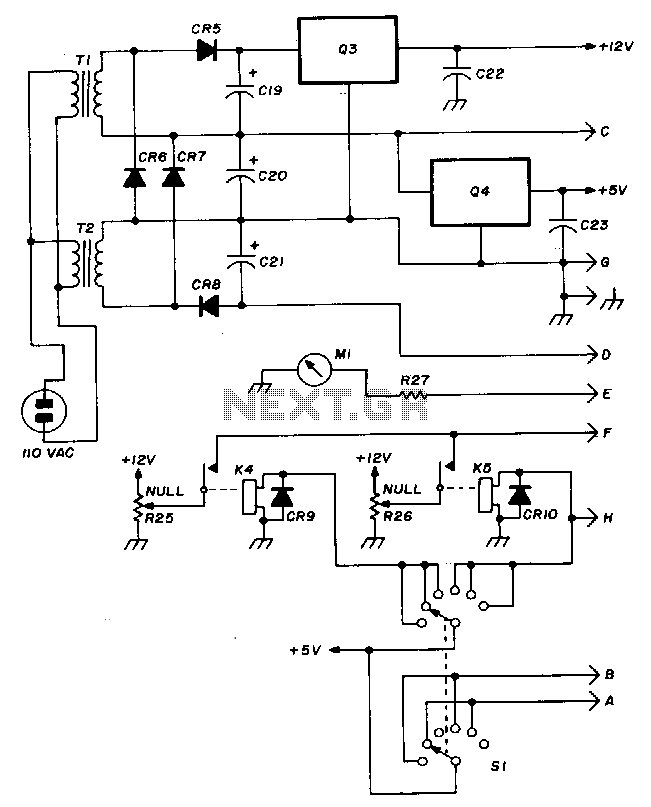
Wide-range-rf-power-meter

The Hewlett-Packard HSCH-3486 zero-bias Schottky diode is utilized as the detector. To avoid employing a modulation detection method, a chopper-stabilized operational amplifier is implemented. The chopper operational amplifier effectively converts the input DC voltage to AC, amplifies it, and then converts it back to DC. The output from the detector is amplified 150 times using the chopper operational amplifier, raising the signal to a level manageable by simpler operational amplifiers, such as the LM11. Offset voltages in the amplifier are nullified using two potentiometers, one for the high range and another for the lower three ranges.
The Hewlett-Packard HSCH-3486 zero-bias Schottky diode serves as a crucial component in high-frequency detection applications due to its low forward voltage drop and fast switching capabilities. This diode functions effectively as a detector in RF applications, where rapid response times are essential for accurate signal processing.
The implementation of a chopper-stabilized operational amplifier in this configuration is significant. The chopper op-amp operates by periodically interrupting the input signal, converting it to an AC signal, and amplifying it. This method mitigates the effects of offset voltage and drift, which are common in traditional amplifiers. The AC signal is then demodulated back to a DC level, ensuring that the output is stable and suitable for further processing.
The amplification factor of 150 times is critical, as it elevates the weak signal from the Schottky diode to a range that can be effectively handled by subsequent stages of the circuit, particularly simpler op-amps like the LM11. The LM11, known for its low noise and high gain, can process the amplified signal without introducing significant distortion.
To ensure precision in signal processing, offset voltages within the amplifier are adjusted using two potentiometers. This dual-potentiometer configuration allows for fine-tuning across different ranges, accommodating variations in signal strength and ensuring that the output remains accurate across a broad spectrum of input conditions. The first potentiometer is designated for high-range adjustments, while the second is tailored for lower ranges, providing flexibility and precision in the overall circuit performance.
This design exemplifies the integration of advanced components to achieve reliable signal detection and amplification, making it suitable for various applications in electronic systems where high sensitivity and accuracy are required.The Hewlett-Packard HSCH-3486 zero-bias Schottky diode is used as the detector. To avoid using a modulation method of detection, a chopperstabilized op amp is used. The chopper op amp basically converts the input de voltage to ac, amplifies it, and converts it back to de. Amplifying the de output from the detector 150 times with a chopper op amp puts the signal at a level that simpler op amps, such as the LMll, can handle.
Offset voltages in the amplifier are nulled with two pots, one for the high range and one for the lower three ranges. 🔗 External reference
The Hewlett-Packard HSCH-3486 zero-bias Schottky diode serves as a crucial component in high-frequency detection applications due to its low forward voltage drop and fast switching capabilities. This diode functions effectively as a detector in RF applications, where rapid response times are essential for accurate signal processing.
The implementation of a chopper-stabilized operational amplifier in this configuration is significant. The chopper op-amp operates by periodically interrupting the input signal, converting it to an AC signal, and amplifying it. This method mitigates the effects of offset voltage and drift, which are common in traditional amplifiers. The AC signal is then demodulated back to a DC level, ensuring that the output is stable and suitable for further processing.
The amplification factor of 150 times is critical, as it elevates the weak signal from the Schottky diode to a range that can be effectively handled by subsequent stages of the circuit, particularly simpler op-amps like the LM11. The LM11, known for its low noise and high gain, can process the amplified signal without introducing significant distortion.
To ensure precision in signal processing, offset voltages within the amplifier are adjusted using two potentiometers. This dual-potentiometer configuration allows for fine-tuning across different ranges, accommodating variations in signal strength and ensuring that the output remains accurate across a broad spectrum of input conditions. The first potentiometer is designated for high-range adjustments, while the second is tailored for lower ranges, providing flexibility and precision in the overall circuit performance.
This design exemplifies the integration of advanced components to achieve reliable signal detection and amplification, making it suitable for various applications in electronic systems where high sensitivity and accuracy are required.The Hewlett-Packard HSCH-3486 zero-bias Schottky diode is used as the detector. To avoid using a modulation method of detection, a chopperstabilized op amp is used. The chopper op amp basically converts the input de voltage to ac, amplifies it, and converts it back to de. Amplifying the de output from the detector 150 times with a chopper op amp puts the signal at a level that simpler op amps, such as the LMll, can handle.
Offset voltages in the amplifier are nulled with two pots, one for the high range and one for the lower three ranges. 🔗 External reference